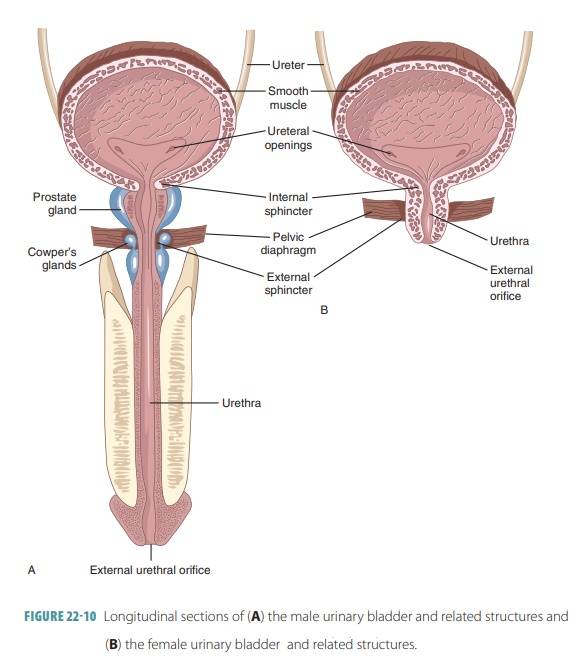Urinary Bladder
| Home | | Anatomy and Physiology | | Anatomy and Physiology Health Education (APHE) |Chapter: Anatomy and Physiology for Health Professionals: Urinary System
The urinary bladder is a hollow, muscular organ that stores urine and forces it into the urethra.
Urinary
Bladder
The urinary bladder
is a hollow, muscular organ that stores urine and forces it into the urethra.
It is found in the pelvic cavity behind the symphysis pubis, beneath the
parietal peritoneum. In males, the prostate gland is inferior to the neck of
the bladder, which empties into the urethra. In females, the bladder is
anterior to the uterus and vagina. The wall of the bladder has many folds or rugae when it is empty, but these smooth
out as it fills. The bladder is pear shaped when full, rising superiorly in the
abdominal cavity. The rugae disappear
as the bladder walls become thinner due to stretching to contain urine. Because
of the flexibility of its walls, there is no large rise in internal pressure as
the bladder fills.
The bladder’s internal floor has a triangular area or trigone, which has an opening at each of
its three angles. FIGURE
22-10 shows both the male and female urinary bladder and related
structures. The urinary bladder wall has four layers—the mucous coat,
sub-mucous coat, muscular coat, and serous coat—and its cellular thickness changes
based on how much urine it holds. The smooth muscle fibers of the muscular coat
are interlaced, comprising the detrusor
muscle, part of which surrounds the neck of the bladder to form the internal urethral sphincter.
This muscle is innervated with parasympathetic nerve fibers that function in
the micturition reflex. The mucous coat of the urinary bladder contains
transitional epithelium. The urinary bladder is held in place by the median and lateral umbilical ligaments.

Micturition, also called urination or voiding, is the process of expelling urine from the urinary bladder. The detrusor muscle contracts along with the abdomi-nal wall and pelvic floor muscles, and the external ure-thral sphincter relaxes. The micturition reflex center in the spinal cord sends parasympathetic motor impulses to the detrusor muscle, causing it to rhythmically contract. In infants and young children, micturition is reflexive. However, training to control micturition usually is successful between ages 2 and 3, because descending brain circuits have matured sufficiently to take control of micturition replacing reflexive micturi-tion. In older children and adults, the normal urge to urinate usually occurs before urine volume in the blad-der exceeds 500 mL. After urination, there is usually only approximately 10 mL of urine left over.
The urinary bladder may hold up to nearly 1,000 mL or 2
pints of urine, if necessary. However, the urge to urinate usually occurs once
it contains around 200 mL. When approximately half full, the bladder is about
12 cm or 5 inches long, although it can greatly increase in size. The external
urethral sphincter is under con-scious control, allowing the micturition reflex
to occur once the person decides to urinate. The detrusor muscle contracts and
urine flows through the urethra.
